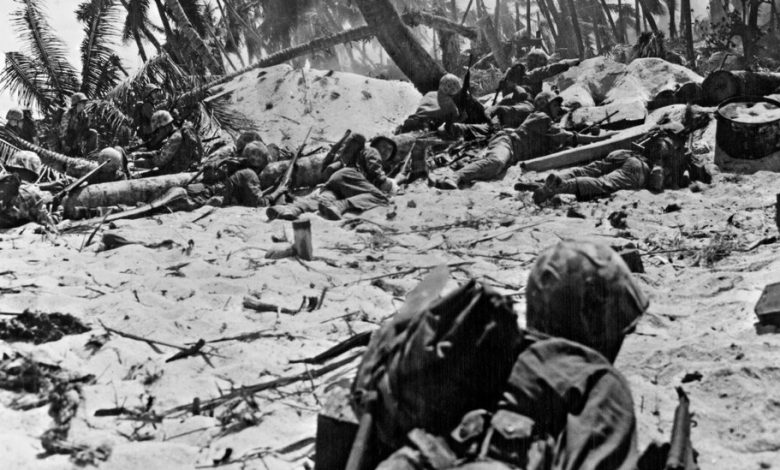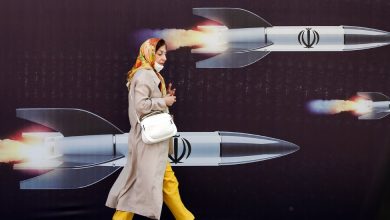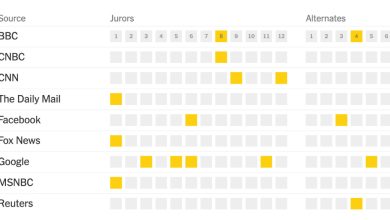The Bloody, 76-Hour Battle on a Tiny Atoll That Helped End World War II

Over three days of intense fighting, thousands of soldiers perished on beaches and in the ocean for a prize — a strategic speck of coral sand and its critical air strip, in the middle of the Pacific — that would help decide the outcome of World War II.
Eighty years ago, the United States military attacked the island of Betio, part of the Tarawa atoll in what is today the archipelago nation of Kiribati, to wrest it from Japanese control.
At just 2.5 miles in length, Betio had little significance. But its location would allow the United States to move northwest: first to the Marshall Islands, then to the Mariana Islands and eventually to Japan itself. These were the “leapfrogging” tactics the Allies used in the Pacific to weaken Japan’s control of the region, as well as to establish bases to launch further attacks.
On Betio, the United States military had expected an easy conquest by air and sea, a so-called amphibious assault involving about 18,000 Marines and an additional 35,000 troops. But awaiting them were heavy Japanese fortifications, including concrete bunkers and cannons along the sandy fringes of the atoll and some 5,000 troops, nearly a quarter of them enslaved Korean laborers, on the front line.
Writing in The New York Times in 1943, Sgt. James G. Lucas described the grim early indications that the plan had faltered: “‘We have landed against heavy opposition,’ came the first word from shore. ‘Casualties severe.’”
The American troops were well armed, with thousands of pounds of explosives and a fleet of warships and amphibious vehicles. But, faced with an unexpected low tide, the Marines were forced to abandon their ships offshore and wade toward the island — where they were gunned down by waiting Japanese snipers, leaving a jumble of floating bodies for their compatriots to navigate.
“There was no way to get out of the line of fire,” Leon Cooper, the commander of a U.S. Navy landing boat that was part of the assault, said decades later, in the 2009 documentary “Return to Tarawa.” “Every goddamned angle was covered. We bumbled and stumbled into all this slaughter.”
The turning point in the battle came on the second day, in the form of millions of American bullets and hundreds of tons of explosives.
“Strafing planes and dive-bombers raked the island,” Robert Sherrod, a war correspondent for Time magazine, wrote in a dispatch. “Light and medium tanks got ashore, rolled up to fire high explosive charges point-blank into the snipers’ slots of enemy forts.”
By the end of three days of warfare, more than 1,000 Marines and about 4,500 soldiers on the Japanese side had died, and thousands more were injured.
“The waterlogged bodies on the coral flats were gathered up, the crude island graveyards were filled,” Mr. Sherrod wrote.
He was part of a contingent of photographers, camera operators and correspondents who accompanied American troops to Tarawa. Their work made the battle one of the most closely documented fights of the war, and produced the Academy Award-winning documentary film “With the Marines at Tarawa.”
Those images were barely censored before being shown to American audiences, and prompted outrage at home. Instead of scenes of victory, the American public was confronted by haunting images in which, as Mr. Sherrod described it, “riddled corpses formed a ghastly fringe along the narrow white beaches, where men of the Second Marine Division died for every foot of sand.”
The Battle of Tarawa was fought for 76 hours between Nov. 20 and 23, 1943. What follows is a selection of photographs from the fighting, as captured by American photographers.
The first image shows U.S. Marines on a landing barge approaching Tarawa in November 1943.

Credit…National Archives
Two months earlier, American forces launched airstrikes on the Japanese airfield at Tarawa..
Marines wading through water under enemy fire, as a low tide and a coral reef initially stopped landing boats from coming on shore.
A Marine looking at the half-buried body of a Japanese soldier.
Marines approaching a Japanese bunker. Tarawa was one of the most fortified atolls America would invade in the Pacific during the war. Japanese forces had constructed dug-in concrete bunkers called pillboxes, sea walls and an extensive trench system.
Marines resting beside an amphibious landing vehicle on a beach.
Bodies of soldiers lying on the beach at Betio where they had been obliged to wade to shore under enemy fire in the first stage of the attack.
A Marine firing at Japanese soldiers hidden in a pillbox, as American soldiers pushed inland.
Marines charging across open ground from the beach to the airstrip, with some soldiers carrying spades to build cover for themselves in the sand. The airstrip, which divided the island into north and south, was the main objective of the assault on the atoll. It would prove a highly valuable asset for the Allies, who launched the Marshalls campaigns about 10 weeks after the United States had captured Tarawa.
Marines wounded during the battle being sent back to a ship in a landing barge.
A combat correspondent interviewing a Marine during the battle.
The bodies of a Marine and a Japanese soldier lie in a clearing.
Marines drinking Japanese beer and sake taken from Japanese fortified positions at the end of the battle.
A combat photographer examining the remains of a Japanese Shinto shrine, after the battle.
Japanese and Korean prisoners after the American victory. Only one Japanese officer and 16 enlisted men surrendered; the rest of the garrison died in combat or by suicide. Most of the prisoners were Korean laborers who had been brought to the atoll to build Japanese defenses.
Graves of Marines marked with artillery shells and helmets.
A Marine patrolling the beach at Tarawa in December 1943, with two captured Japanese naval guns in the background.




